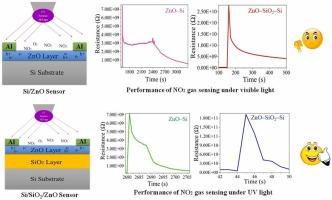当前位置:
X-MOL 学术
›
J. Alloys Compd.
›
论文详情
Our official English website, www.x-mol.net, welcomes your
feedback! (Note: you will need to create a separate account there.)
Ultrasensitive NO2 gas detection using ALD-grown ZnO-SiO2/Si thin film-based UV sensors
Journal of Alloys and Compounds ( IF 5.8 ) Pub Date : 2024-11-19 , DOI: 10.1016/j.jallcom.2024.177673 Bhavya Padha, Zahoor Ahmed, Shankar Dutta, Akhilesh Pandey, Naresh Padha, Monika Tomar, Anjali Sharma, Isha Yadav, Sandeep Arya
Journal of Alloys and Compounds ( IF 5.8 ) Pub Date : 2024-11-19 , DOI: 10.1016/j.jallcom.2024.177673 Bhavya Padha, Zahoor Ahmed, Shankar Dutta, Akhilesh Pandey, Naresh Padha, Monika Tomar, Anjali Sharma, Isha Yadav, Sandeep Arya

|
In this study, nitrogen dioxide (NO2 ) gas sensors based on zinc oxide-silicon (ZnO–Si) and zinc oxide-silicon dioxide-silicon (ZnO–SiO2 –Si) configurations were fabricated to study their response to ultraviolet (UV) radiation at room temperature (300 K). Single and polycrystalline ZnO layers were deposited using atomic layer deposition (ALD) on silicon and silica substrates. The structure and composition of the films were studied using various characterization techniques. The current-voltage (I-V) characteristics of these sensors’ UV illumination (∼365 nm) have been investigated. The gas sensing performance of both configurations was analyzed with and without the UV source for varied concentrations of NO2 gas. Exposure to UV light significantly improved the recovery times of the sensors. Specifically, the recovery time for the Si-based sensor decreased from 1578 seconds to 24 seconds, while for the SiO2 -based sensor, it reduced from 540 seconds to 5 seconds. The response time of ZnO–Si was found to be 2 seconds and ZnO–SiO2 –Si to be 1 second. Under irradiation, the sensitivity factor increased from 8.29 × 107 to 5.79 × 108 % ppm−1 for the ZnO–SiO2 –Si sensor. It reached a maximum value of 9.12 × 1011 % ppm−1 , which is extremely high compared to similar devices.
中文翻译:

使用 ALD 生长的 ZnO-SiO2/Si 薄膜基 UV 传感器进行超灵敏的 NO2 气体检测
在这项研究中,制造了基于氧化锌-硅 (ZnO-Si) 和氧化锌-二氧化硅-硅 (ZnO-SiO2-Si) 配置的二氧化氮 (NO2) 气体传感器,以研究它们在室温 (300 K) 下对紫外线 (UV) 辐射的响应。使用原子层沉积 (ALD) 在硅和二氧化硅衬底上沉积单晶和多晶 ZnO 层。使用各种表征技术研究了薄膜的结构和成分。已经研究了这些传感器的紫外照度 (∼365 nm) 的电流-电压 (I-V) 特性。对于不同浓度的 NO2 气体,分析了有和没有 UV 源的两种配置的气体传感性能。暴露在紫外线下可显著缩短传感器的恢复时间。具体来说,硅基传感器的恢复时间从 1578 秒减少到 24 秒,而硅基传感器的恢复时间从 540 秒减少到 5 秒。发现 ZnO-Si 的响应时间为 2 秒,ZnO-SiO2-Si 为 1 秒。在辐照下,ZnO-SiO2-Si 传感器的灵敏度因子从 8.29 × 107 增加到 5.79 × 108 % ppm-1。它达到了 9.12 × 1011% ppm-1 的最大值,与类似设备相比,这是非常高的。
更新日期:2024-11-19
中文翻译:

使用 ALD 生长的 ZnO-SiO2/Si 薄膜基 UV 传感器进行超灵敏的 NO2 气体检测
在这项研究中,制造了基于氧化锌-硅 (ZnO-Si) 和氧化锌-二氧化硅-硅 (ZnO-SiO2-Si) 配置的二氧化氮 (NO2) 气体传感器,以研究它们在室温 (300 K) 下对紫外线 (UV) 辐射的响应。使用原子层沉积 (ALD) 在硅和二氧化硅衬底上沉积单晶和多晶 ZnO 层。使用各种表征技术研究了薄膜的结构和成分。已经研究了这些传感器的紫外照度 (∼365 nm) 的电流-电压 (I-V) 特性。对于不同浓度的 NO2 气体,分析了有和没有 UV 源的两种配置的气体传感性能。暴露在紫外线下可显著缩短传感器的恢复时间。具体来说,硅基传感器的恢复时间从 1578 秒减少到 24 秒,而硅基传感器的恢复时间从 540 秒减少到 5 秒。发现 ZnO-Si 的响应时间为 2 秒,ZnO-SiO2-Si 为 1 秒。在辐照下,ZnO-SiO2-Si 传感器的灵敏度因子从 8.29 × 107 增加到 5.79 × 108 % ppm-1。它达到了 9.12 × 1011% ppm-1 的最大值,与类似设备相比,这是非常高的。

































 京公网安备 11010802027423号
京公网安备 11010802027423号